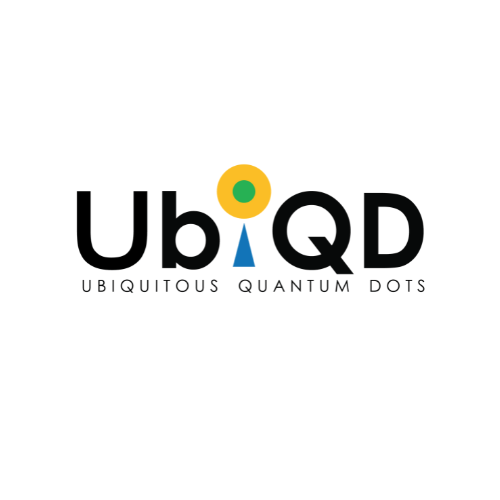A Further Look at UbiQD’s Quantum Dot Technology for Agriculture, Solar, and Beyond

In 2023, the Nobel Prize in Chemistry was awarded to several scientists for the discovery and development of the quantum dot. These vanishingly small particles, about 10,000 times smaller than the width of a human hair, are known for their high efficiency and tunable photoluminescence (PL), offering a spectrum of light emission across various colors. The uniqueness of quantum dots lies in their onion-like structure, with multiple layers shielding the core material and their surface covered in organic molecule ‘hairs.’
While quantum dots are most commonly seen in high-resolution digital displays, companies like Los Alamos-based UbiQD (pronounced “ubiquity”) are at the forefront of harnessing the remarkable properties of quantum dots (QDs) in agriculture and solar energy.
“Quantum dots allow us to create a new product category in agriculture using fluorescence,” explained UbiQD CEO and Founder Dr. Hunter McDaniel to Inside Quantum Technology.
A key aspect of UbiQD’s approach is the precision in tuning the size and composition of these quantum dots. This is achieved by meticulously adjusting manufacturing conditions, allowing a shift in absorption onset and PL spectrum across wavelengths. Notably, UbiQD specializes in CIS (copper, Indium, Sulphide) quantum dots, capitalizing on their size and tunability to replace traditional fluorescent dyes or doped phosphors.
“Dyes are traditionally unstable,” McDaniel elaborated. “Often fading occurs, and so many films used in agricultural settings like greenhouses have to use ultraviolet (UV) stabilizers to avoid destabilization.”
Quantum Dots in Agriculture
Currently, UbiQD is concentrating on advancing quantum dot applications for sustainable agriculture and clean energy, particularly optimizing sunlight in greenhouses and enhancing solar module efficiency. In agriculture, UbiQD’s quantum dots are engineered for integration into greenhouse coverings, maximizing the benefits of natural light for plant growth to increase crop yield and quality. UbiQD is also pioneering the development of quantum dots to improve solar panel efficiency, aiming to revolutionize solar energy capture. Beyond these applications, UbiQD is exploring the application of their technology for solar windows and security inks, offering solutions for smart building designs and anti-counterfeiting measures
“This design has a lot of potential,” McDaniel added. “With different tunable light settings, you can actually change the composition of your crop, such as making it have more sugar content or color.”
But before McDaniel and the UbiQD team decide to pursue more colors of their quantum dot products (which can produce these effects), they’re more focused on making the technology as affordable as possible.
Because quantum dots can be used for various applications, their affordability is key to penetrating different markets. UbiQD has developed a patented, scalable process for creating quantum dots that relies on thermodynamics rather than complex engineering, making its products more accessible. UbiQD operates as a materials manufacturer and technology source, directly selling quantum dots and films through distributors. They envision a long-term B2B model, leveraging existing market channels.
“Our goal is to make our product as widely accessible as possible with as many different crop applications as possible,” McDaniel added. “To do this we are scaling our manufacturing process and making our quantum dot films more easily integrated into the current farming infrastructure.”
Because most farming facilities worldwide (particularly near the equator) use plastic films draped over metal greenhouse frames, the UbiQD team hopes to replace these normal plastic sheets with their quantum dot product.
“Now you have a roof that can boost your crop production, which, for farmers, means wider profit margins,” said McDaniel.
UbiGro Cover, one of the company’s newest products under their child brand UbiGro, was recently released in mid-November as a greenhouse cover film, which can enhance photosynthesis through tunable fluorescence. The first line of this product will ship to growers worldwide in March.
As McDaniel explained, UbiGro is roughly six times cheaper than a previous design, with each square foot costing 50 cents. While UbiGro only comes in one color, McDaniel plans to expand to other colors targeted at different crops.
The Radiance of Quantum Dots
The brilliance of quantum dots stems from their efficiency in converting absorbed light into emitted light. UbiQD leverages precision process control and protective shells to achieve near-unity quantum yields (emitting nearly 100% of light as they absorb) and stability, even in challenging external environments. This high efficiency spans from the visible to the near-infrared (NIR) range.
McDaniel and his team use the quantum dots’ ability to absorb light to develop solar energy-focused products, including solar windows.
“We see quantum dots as a lynchpin into new markets,” McDaniel added. “Solar energy is one of these markets. We’ve seen quantum dots be able to enhance current solar products, possibly even ten times as much.”
A Focus on Safety
Besides creating a more radiant and tunable product, UbiQD also works to make its manufacturing process safer. Traditional quantum dot synthesis often involves hazardous materials like cadmium, lead, or phosphines. In contrast, UbiQD focuses on safer quantum dots made from everyday materials like copper, zinc, and sulfur, holding exclusive licenses for these dots from prestigious institutions like MIT and Los Alamos National Lab.
A Bright Future for UbiQD
Looking to the future, UbiQD’s technology could revolutionize numerous other sectors. The unique properties of their quantum dots could find applications in medical imaging, where their tunable fluorescence can aid in precise diagnostics. In electronics, these quantum dots could enhance the color and efficiency of displays in devices like smartphones and TVs. Furthermore, the environmental and safety benefits of UbiQD’s quantum dots make them ideal for sustainable development initiatives, potentially contributing to cleaner and more efficient energy solutions worldwide. With their innovative approach to quantum dot technology, UbiQD is poised to impact various industries, harnessing the power of these tiny particles to bring about significant advancements.
Kenna Hughes-Castleberry is the Managing Editor at Inside Quantum Technology and the Science Communicator at JILA (a partnership between the University of Colorado Boulder and NIST). Her writing beats include deep tech, quantum computing, and AI. Her work has been featured in Scientific American, Discover Magazine, New Scientist, Ars Technica, and more.


















